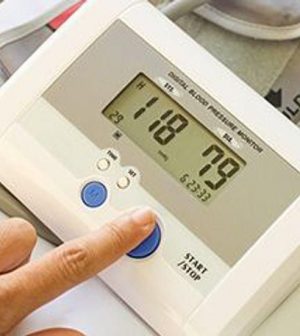- Skip Storing This Everyday Product in the Fridge Door
- Green Tea + B3 Pairing May Boost Brain Health
- Navigating Your Midlife Crisis: Embracing New Possibilities
- City Raccoons Showing Signs of Domestication
- Mapping the Exposome: Science Broadens Focus to Environmental Disease Triggers
- One Week Less on Social Media Linked to Better Mental Health
- Your Brain Changes in Stages as You Age, Study Finds
- Some Suicide Victims Show No Typical Warning Signs, Study Finds
- ByHeart Formula Faces Lawsuits After Babies Sickened With Botulism
- Switch to Vegan Diet Could Cut Your Greenhouse Gas Emissions in Half
What’s More Accurate, Blood Pressure Readings at Home or Doctor’s Office?

Regular blood pressure readings at home are more accurate for diagnosing high blood pressure than those taken at a doctor’s office, according to a new study.
“Blood pressure varies a lot over the day … and one or two measurements in clinic may not reflect your average blood pressure,” said study author Dr. Beverly Green, a senior investigator at Kaiser Permanente Washington Health Research Institute in Seattle. “Home blood pressure monitoring allows you to collect many more readings and average these.”
The study included 510 adults at high risk of developing high blood pressure. They were divided into groups who got blood pressure readings in three different ways: at home; in a Kaiser clinic; or at kiosks in pharmacies and other locations.
All of the patients also received 24-hour ambulatory blood pressure monitoring (ABPM). ABPM is the gold standard for diagnosing high blood pressure, but it’s not widely available for use. The portable device is worn continuously for 24 hours, providing blood pressure readings every 20 to 30 minutes during the day and every 30 to 60 minutes at night.
The researchers found that blood pressure readings taken at home were consistent with ABPM, according to findings published online March 3 in the Journal of General Internal Medicine.
Compared to ABPM, readings at clinic visits were significantly lower for the systolic measure. The systolic reading measures the pressure in your arteries when your heart beats. It’s the top number in a blood pressure reading. Diastolic blood pressure, the bottom number, measures the pressure in your arteries between heart beats. Normal blood pressure is 120/80 or lower.
Blood pressure readings from kiosks were significantly higher than ABPM readings, resulting in a higher likelihood of overdiagnosis of high blood pressure.
“Home blood pressure monitoring was a better option, because it was more accurate than clinic blood pressure readings,” Green said in a Kaiser news release. “Furthermore, a companion study found that patients preferred taking their blood pressure at home.”
It’s believed that millions of U.S. adults have untreated high blood pressure, which can cause heart attack, stroke, kidney damage and other problems. When high blood pressure is diagnosed, doctors typically prescribe drugs to get levels under control.
More information
For more on high blood pressure, go to the U.S. National Heart, Lung, and Blood Institute.
SOURCE: Kaiser Permanente, news release, March 3, 2022
Source: HealthDay
Copyright © 2025 HealthDay. All rights reserved.










